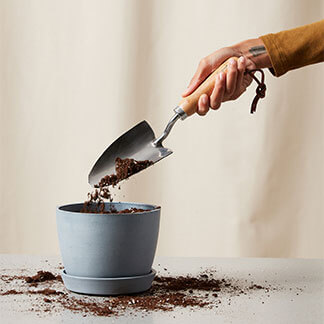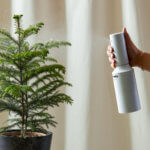How to care for your Euphorbia
Use these instructions to care for an Euphorbia. This guide will tell you how to water an Euphorbia; its light, temperature, humidity preferences and any additional care it might need to help it grow.
African Milk Tree
Your euphorbia needs bright direct light. This means a spot that gets 6 plus hours of direct sun per day.
Water your euphorbia when the soil volume is 100% dry. Water thoroughly until it flows out of the drainage hole. Discard excess water to discourage root rot.
Euphorbias do well in dry to average household humidity.
Your euphorbia prefers temperatures between 60-90°F.
Fertilize once in the spring and summer with a cacti or succulent fertilizer.
The euphorbias are toxic to humans and pets.
Be sure to wear gloves when handling your euphorbia as it oozes a milky substance that is irritating to the skin and eyes if handled incorrectly.
Candelabra Cactus
Your Candelabra Cactus will do well in bright light to full sun. If it doesn’t receive enough light, the branches and stems will become leggy and stretched out.
Water only when the soil is completely dry. Water until liquid flows through the drainage hole at the bottom of the pot and discard any water that has accumulated in the saucer.
This plant requires no additional humidity.
Your Candelabra Cactus prefers temperatures between 60-85 degrees.
Before applying any type of plant food, make sure the soil is already damp-never apply to dry soil. Your Candelabra Cactus requires fertilizer once in the spring and once in the summer. Apply an all-purpose, liquid plant food diluted to half strength. Do not fertilize your Candelabra in the fall or winter when plant growth naturally slows.
Your Candelabra Cactus is moderately toxic to pets and humans. Typically, ingestion will cause mouth and stomach irritation and possible vomiting.
If you notice a white, crusty substance on the soil surface of a Candelabra Cactus, it is fertilizer salt that needs to be flushed from the soil. Remove the salt layer if it’s thick, and then water the plant slowly with twice the volume of water that the pot holds. Allow the soil to drain completely, and don’t let the pot stand in water. The fertilizer salt-flushing procedure can be done 1-2 times each year if it is necessary.
Crown of Flowers
Your Crown of Flowers prefers bright indirect light. Direct morning sunlight is fine for this plant, but avoid prolonged exposure to direct sun which can scorch the leaves.
Water when 75% of the soil volume is dry. Add water slowly, allowing it to soak into the soil until it flows through the drainage hole. Discard water that accumulates in the saucer.
This plant does well in average household humidity.
This plant prefers temperatures between 60-90°F. Avoid drafty areas and temperatures below 55°F in the winter.
Feed monthly during periods of active growth with an all-purpose fertilizer for indoor plants. Never apply fertilizer to dry soil.
This plant is considered toxic to humans and pets if ingested.
Crown of Flowers growth will naturally slow in the winter and watering frequency should be reduced. Stems can be cut back to reduce the plant’s height and will bear new leaves and flowers in the spring. Cutting the plant produces a milky sap that can irritate sensitive skin.
Ghost Cactus
Your Ghost Cactus needs bright direct light. This means a spot that gets 6 plus hours of direct sun per day.
Water your Ghost Cactus when the soil volume is 100% dry. Water slowly, allowing it to soak into the soil, until liquid flows through the drainage hole at the bottom of the pot. Discard any water that has accumulated in the saucer.
Ghost Cacti do well in dry to average household humidity.
Your Ghost Cactus prefers temperatures between 60-90°F.
Fertilize once in the spring and summer with a cacti or succulent fertilizer. Never apply fertilizer to dry soil.
Ghost Cacti are toxic to humans and pets if ingested.
Be sure to wear gloves when handling your plant as it oozes a milky substance that is irritating to the skin and eyes if handled incorrectly.
Pencil Cactus
The Pencil Cactus needs bright direct light. This means a spot that gets 6 or more hours of direct sun per day like an unobstructed southern or western window.
Water your euphorbia when the soil volume is 100% dry. Water thoroughly until it flows out of the drainage hole. Discard excess water to discourage root rot.
Euphorbias do well in dry to average household humidity.
Your euphorbia prefers temperatures between 60-90°F.
Fertilize once in the spring and summer with a cacti or succulent fertilizer.
The Pencil Cactus is toxic to humans and pets.
Be sure to wear gloves when handling the Pencil Cactus as it oozes a milky substance that is irritating to skin and eyes if handled incorrectly. You can easily propagate your euphorbia by cuttings. Use a sharp knife to make a clean cut at a stem joint. Allow the cut surface to callus over for a week and pot with fresh cactus soil. Withhold water for a week before watering normally. You should see roots taking hold in a month or so.
Poinsettia
Poinsettias love bright but indirect sunlight. An eastern window is ideal, or a few feet back from a southern or western window. Watch out for pale bleached leaves as this is a sign your plant is getting too much direct sun.
You should water your poinsettia when the top 50% of soil is dry. Water slowly until you see water begin to trickle out of the pot’s drainage hole, and make sure you let excess water fully drain out. Discard any excess water after a few minutes.
Poinsettias enjoy humidity between 50% – 75% ambient humidity. You can boost humidity by misting, adding a pebble tray, or placing a humidifier nearby.
Poinsettia flowers appreciate daytime temperatures between 65-75° F and nighttime temperatures of 55-60° F. Keep your poinsettia away from drafty windows or doors, and any open vents.
You can give your poinsettia a boost with fertilizer for flowering plants. Fertilize once a month after the plant begins growing again in the spring and throughout the growing season and into the fall. No fertilizer is needed during the winter months.
Toxic only if ingested in very high amounts to pets and humans. The sap can be irritating to the mouth and stomach if ingested, sometimes causing vomiting. The sap may also cause a very mild allergic skin reaction in some people.
To encourage your plant to take on a full, bushy shape, prune the stems back in spring and allow the plant to flush out new growth. To encourage the plant to rebloom, ensure the plant receives complete darkness for 14 hours a day for a span of 8 weeks, beginning in mid to late September. This signals the plant to begin producing flower buds and colorful bracts in time for the holiday season.














